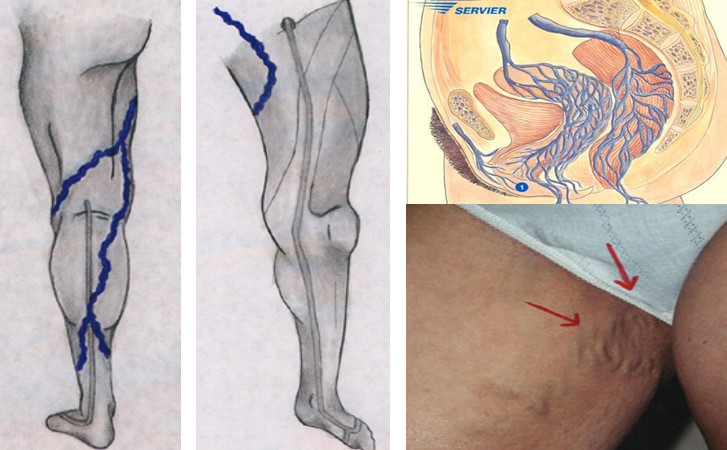10 Common Causes of Groin Pain in Women
Groin pain in women can be both confusing and distressing. It might arise from something as simple as everyday activity but can also indicate more serious underlying health issues. While many cases are benign and related to musculoskeletal or gynecological problems, groin pain can also be linked to vascular conditions. Understanding when to seek medical advice and the potential causes is essential in managing your health.
When Should I See a Doctor About Groin Pain?
Groin pain can stem from various causes, ranging from muscle strain to more severe conditions like appendicitis or ovarian cysts. If you experience persistent groin pain for more than six months or notice that the pain worsens over time, it’s essential to seek medical advice. Consult your gynecologist, primarily if the issue might be related to gynecological factors such as fibroids, ovarian cysts, or endometriosis. Once gynecological conditions are ruled out, and if the pain persists, it may be time to consider other potential causes, including vascular issues.
If the pain is sudden, severe, or accompanied by symptoms like fever, nausea, or changes in urination, immediate medical attention is necessary. Conditions like appendicitis or hip fractures can cause acute groin pain and require urgent care.
When Should I Ask to See a Vascular Specialist About Groin Pain?
Suppose your groin pain has lasted for six months or longer, and gynecological issues like ovarian cysts, endometriosis, or urinary tract infections (UTIs) have been ruled out. In that case, you might want to ask about seeing a vascular specialist. Conditions like pelvic venous insufficiency (PVI), which is caused by weakened or damaged pelvic veins, can result in groin pain that may go undiagnosed if vascular causes aren’t considered.
Vascular specialists are trained to evaluate and treat conditions related to the veins and arteries, particularly in the pelvis and lower extremities. If you've had multiple pregnancies, a family history of vascular conditions, or experience symptoms like swelling or pressure in the groin, seeing a vascular specialist could help diagnose the issue and provide relief.
How Do I Know My Groin Pain Is a Vascular Issue?
Vascular-related groin pain, such as that caused by pelvic venous insufficiency, often comes with specific symptoms. Persistent groin pain or pressure that lasts for more than six months, especially if accompanied by discomfort during menstruation or sexual intercourse, could indicate a vascular issue. You might also notice swelling in the labial, vaginal, or perineal areas, a sensation of fullness in the pelvis, or varicose veins in the upper thighs.
Talk to your primary care physician or gynecologist about seeing a vascular specialist if you’re experiencing groin pain and have exhausted treatment and diagnostic possibilities, you may be struggling with a vascular issue such as pelvic venous insufficiency.

{Image caption: Varicose veins are enlarged, swollen ones typically occurring in the legs. In some cases, varicose veins can also develop in the pelvic region. This image shows visible varicose veins in the pelvic area and leg. While not all patients with pelvic venous insufficiency experience visible varicose veins, this image demonstrates one possible presentation of the condition.}
10 Things Causing to Have Female Groin Pain
While groin pain can result from various issues, understanding the potential causes is crucial for proper diagnosis and treatment.
Pelvic Congestion Syndrome
Pelvic venous insufficiency, also known as pelvic congestion syndrome (PCS), is a vascular condition that occurs when the veins in the pelvic area become weakened or damaged. This can lead to blood pooling in the pelvic veins, causing pain and pressure in the groin. Women who have had multiple pregnancies or a family history of vascular conditions are at a higher risk for developing PVI. Symptoms may include groin pain, swelling, and discomfort that worsens during menstruation or after sexual intercourse.
Injury or Muscle Strain
A common cause of groin pain, particularly among active women, is muscle strain or injury. The adductor muscles in the thigh are especially vulnerable to injury during running, lifting, or high-intensity workouts. Groin pain from muscle strain often comes on gradually and may worsen with movement. If you've recently started a new exercise regimen or experienced a fall, your groin pain may be linked to a strain or tear in the muscles. Hernia, sprain, muscle strain, or even an injury like a hip fracture or dislocation can cause groin pain. If you suspect you’ve sustained an injury to the hip joint or surrounding muscles, seek medical attention.
Pelvic Inflammatory Disease
Pelvic inflammatory disease (PID) can cause groin pain in women due to inflammation and infection of the reproductive organs. It is often caused by bacterial infections, typically from sexually transmitted infections like chlamydia or gonorrhea. The inflammation can irritate tissues and nerves, leading to pain that may radiate to the groin area. PID can also lead to the formation of adhesions or scar tissue in the pelvic region, causing ongoing pain, especially during physical activities or sexual intercourse. Prompt treatment is essential to prevent complications and manage the pain effectively.
Urinary Tract Infection (UTI)
A urinary tract infection is a common cause of groin pain in women. Bacteria entering the urinary tract can cause discomfort in the lower abdomen and groin, along with symptoms like frequent urination, burning during urination, and sometimes fever. UTIs are easily treated with antibiotics, but if left untreated, they can lead to more severe complications, such as kidney infections.
Kidney Stones
Kidney stones, hard deposits of minerals and salts that form in the kidneys and vary in size, can cause intense pain radiating to the groin as they move through the urinary tract. Symptoms include severe pain in the side or lower abdomen, nausea, and difficulty passing urine. While small kidney stones may pass naturally, larger stones might require medical intervention.
Ovarian Cyst
An ovarian cyst is a fluid-filled sac that forms on the ovary, usually during ovulation. Although most ovarian cysts are harmless and resolve on their own, some can cause groin pain, bloating, and changes in menstruation. If you experience these symptoms along with groin pain, your doctor may perform an ultrasound to check for ovarian cysts.
Appendicitis
Appendicitis is a medical emergency that occurs when the appendix becomes inflamed and infected. The pain usually begins near the belly button and moves to the lower right side of the abdomen, sometimes radiating to the groin. Symptoms can include fever, nausea, and loss of appetite. If you suspect appendicitis, seek medical help immediately, as untreated appendicitis can lead to life-threatening complications.
Endometriosis
Endometriosis is a condition where tissue similar to the lining of the uterus grows outside the uterus, causing pain and inflammation. This tissue responds to hormonal changes during the menstrual cycle, leading to chronic pain in the pelvis and groin. If you’ve been diagnosed with endometriosis or experience symptoms like painful periods, bloating, and pelvic pain, consult with your doctor for proper management of the condition.
Uterine Fibroids
Uterine fibroids can cause pelvic pain by putting pressure on nearby organs, distorting the shape of the uterus, and causing intense menstrual cramps. They may also undergo degeneration, triggering sudden sharp pelvic pain. The severity of the pain varies and should be evaluated by a healthcare provider for the best treatment. The location of the fibroid can also play a role in pain. For example, fibroids located near the cervix or within the uterine lining may cause more pronounced pelvic discomfort, particularly during menstruation or sexual activity.
Adenomyosis
Adenomyosis can cause groin pain in women due to the abnormal growth of endometrial tissue into the muscular walls of the uterus. This leads to inflammation, uterine enlargement, and increased pressure on surrounding tissues. The enlarged uterus, inflamed surrounding tissue, and irritation of nearby nerves and muscles can result in discomfort that radiates into the groin area.
Can Groin Pain Be Treated at Home?
Groin pain caused by minor strains or overuse injuries can often be treated at home with rest, ice, compression, and elevation (RICE). Over-the-counter anti-inflammatory medications may help relieve pain. However, if the pain persists or worsens, it’s important to consult a doctor to rule out more serious underlying causes.
Immediate medical attention is required if you experience sudden, severe groin pain, particularly after a fall, or if the pain is localized to the right side and accompanied by fever or nausea.
These symptoms may indicate conditions like a hip fracture or appendicitis, which require urgent care to prevent complications.
Always err on the side of caution regarding persistent or severe groin pain. A timely diagnosis can make all the difference in effective treatment and recovery.
Treatment for Groin Pain at Center for Vascular Medicine
If gynecological and musculoskeletal causes have been ruled out and you suspect that your groin pain may be related to a vascular issue, the Center for Vascular Medicine can provide expert care. Specializing in deep venous and arterial diseases of the pelvis and lower extremities, our team offers comprehensive evaluations and personalized treatment plans to address your needs.
Find a vascular surgeon near you or schedule a consultation with one of our specialists. We accept most major insurance plans to ensure you receive the necessary care without unnecessary stress.

